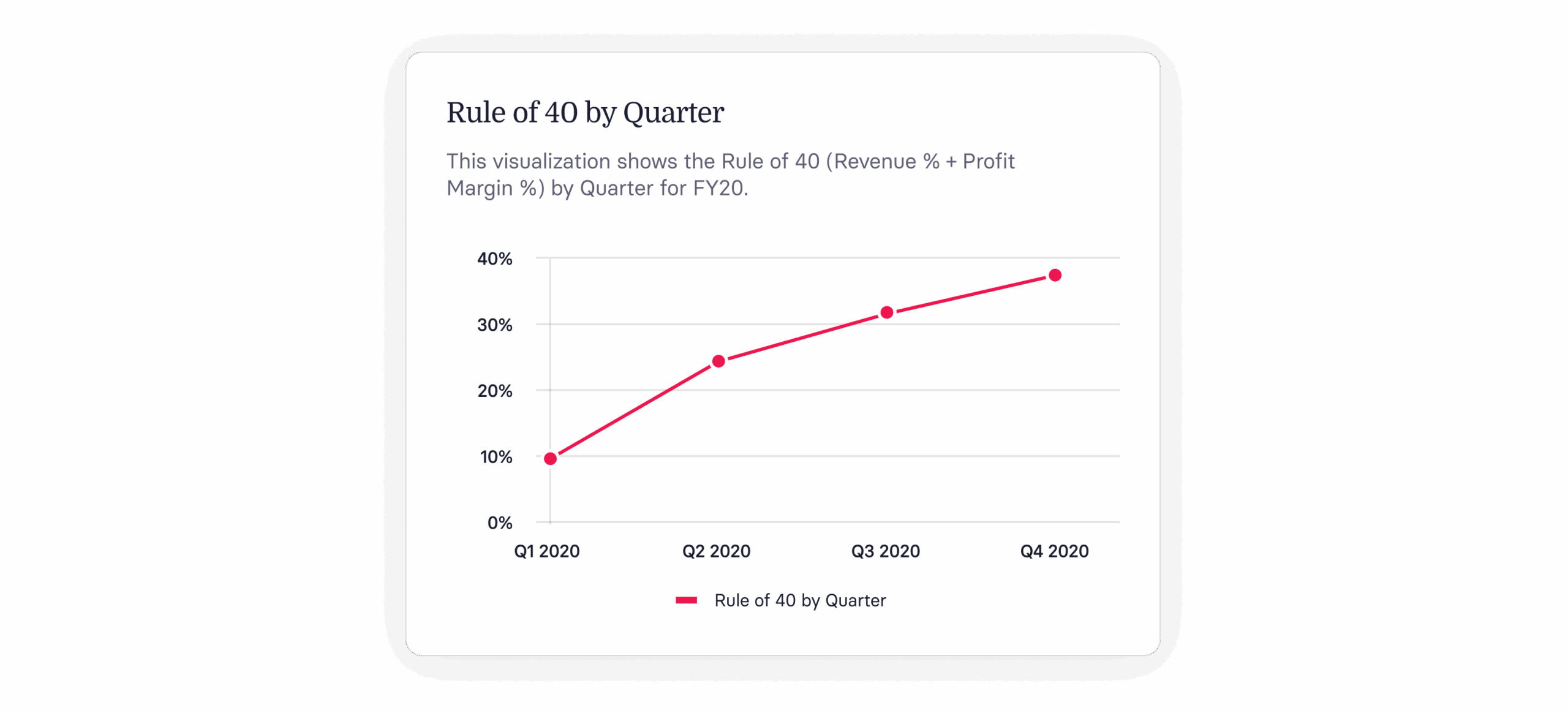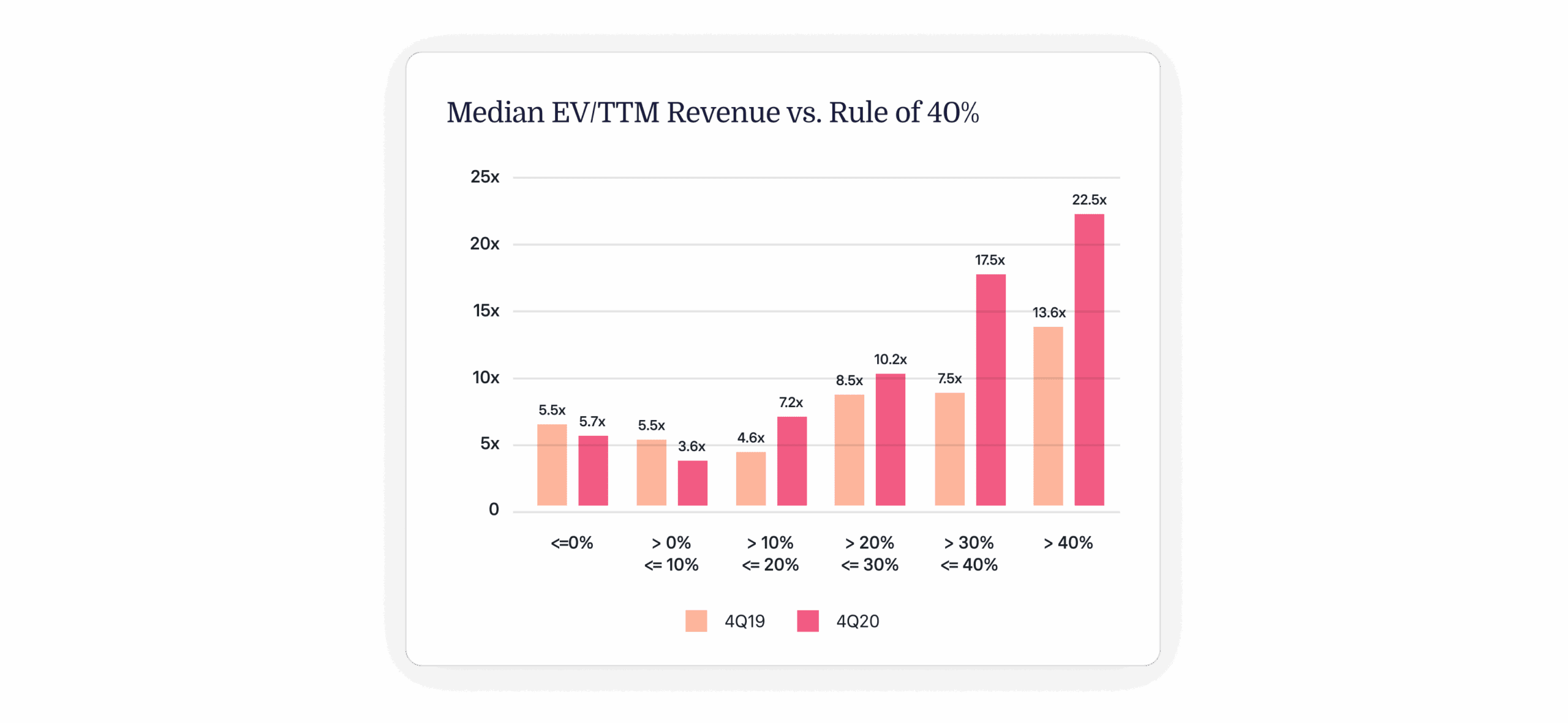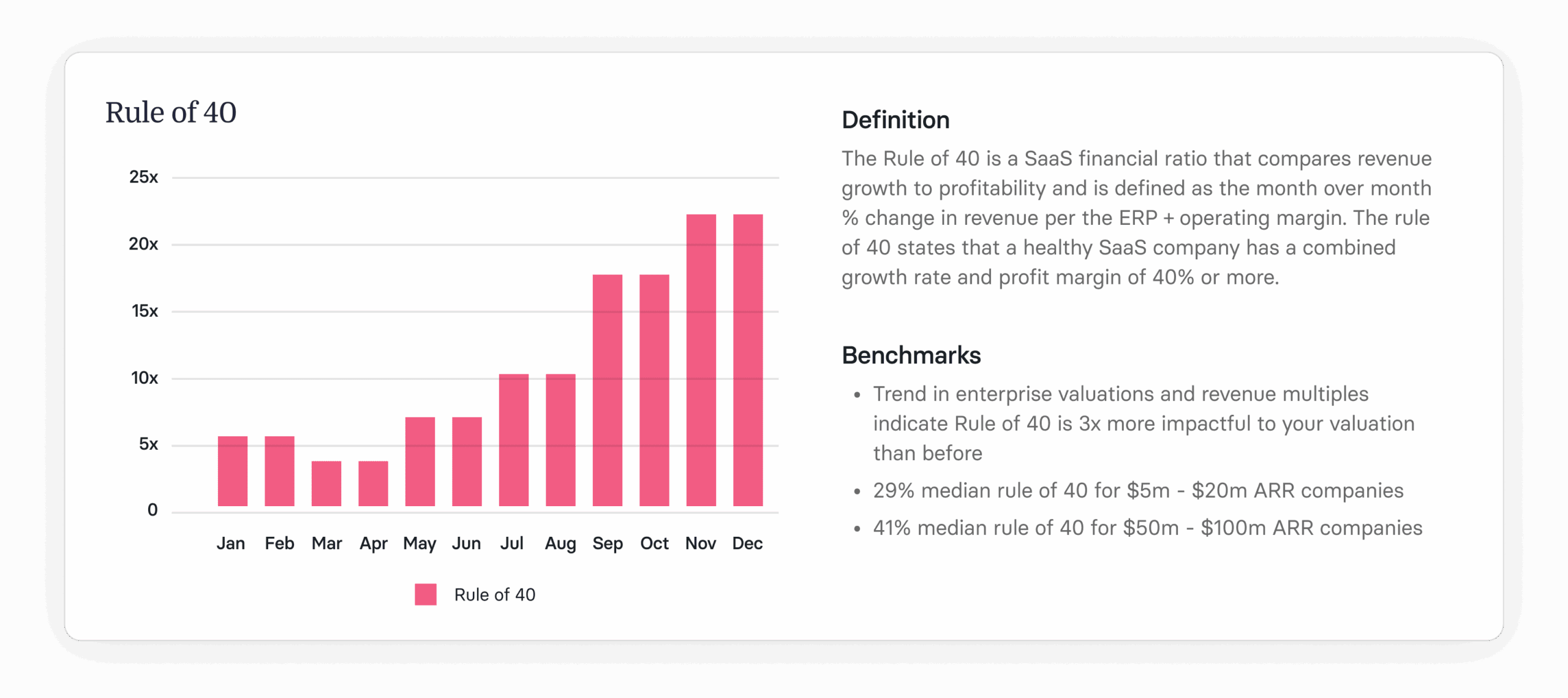The Rule of 40 is a key financial metric for SaaS companies, balancing growth and profitability to reach a combined rate of 40 percent or more.
What is the rule of 40?
The Rule of 40 is a key SaaS benchmark that combines a company’s growth rate and profit margin. The general rule of thumb? A healthy SaaS business should aim for a combined score of 40 percent or higher. It offers a quick, high-level snapshot of business performance by balancing revenue growth with profitability.
<<Download the SaaS metrics cheat sheet today!>>

Chasing rapid growth at the expense of profitability is a familiar strategy for many SaaS startups—but sustainable success doesn’t require a hyper-growth-at-all-costs mindset.
The Rule of 40 offers a benchmark to help you grow more intentionally. Understanding how to calculate it gives you a clear view of your company’s financial health—and supports smarter decisions that can maximize long-term valuation.
Why is the rule of 40 important in SaaS?
Techstars Co-founder Brad Feld introduced the Rule of 40 in 2015 as a way to evaluate the health of SaaS businesses. According to the rule, a SaaS company is considered financially healthy if its growth rate and profit margin add up to at least 40 percent. For instance, growing 40 percent quarter-over-quarter with a 0 percent profit margin would still meet the benchmark.
This makes the Rule of 40 a useful way to assess trade-offs between growth and profitability. Investors may view an unprofitable business as healthy if its growth is strong enough to offset the losses. For example, with a 60 percent growth rate, a company could sustain a 10–20 percent loss and still be considered viable.
That said, the Rule of 40 isn’t a one-size-fits-all metric—it’s most useful when used alongside other financial benchmarks tailored to your business model and stage of growth.
When should you track the rule of 40?
Generally, the Rule of 40 is more relevant for mature SaaS companies than early-stage startups.
In the early days, especially with venture backing, your Rule of 40 score is likely to fluctuate. You may be chasing aggressive growth targets—like the T2D3 path to $100 million—and closing a few large deals could temporarily spike your growth rate to unsustainable levels. At the same time, heavy investments in R&D or go-to-market initiatives can reduce profitability as you work toward product-market fit.
For fast-growing startups, these short-term losses may be worth it if they lead to significant market share gains. But as your company matures, the focus naturally shifts to balancing growth with profitability.
So what defines a “mature” SaaS company? That depends.
- For Techstars Co-founder Brad Feld, it’s when a company reaches at least $1 million in monthly recurring revenue (MRR).
- His Co-founder David Cohen suggests ARR of $15–$20 million.
- Others consider the $50 million ARR mark a key maturity milestone.
Tracking the Rule of 40 too early can lead to misplaced priorities. As SaaS executive and investor Dave Kellogg notes, “many companies target R40 compliance too early, sacrifice growth in the process, and hurt their valuations because they fail to deliver high growth.”
While it’s not a perfect metric, the Rule of 40 becomes increasingly valuable as a benchmark for sustainable growth—especially if you’re preparing for a new round of funding.
<<Uncover essential investor insights with our due diligence checklist.>>
How to calculate the SaaS rule of 40
Calculate the SaaS Rule of 40 by adding growth rate percentage to profit margin for a given time period. You can see the quick Rule of 40 formula below.

Getting your Rule of 40 number isn’t difficult. It’s a simple formula. But if you want an accurate calculation, you need to make sure you’re using the right inputs for your key drivers—growth and profit.
Find the right revenue growth input
Monthly recurring revenue (MRR) is often the preferred growth metric for Rule of 40 calculations, especially since most SaaS businesses rely on subscription-based models. However, MRR isn’t a GAAP metric, so it doesn’t appear on standard financial statements.
To make MRR more accessible and consistent for tracking, many finance teams use accrual accounting and amortize revenue over a 12-month period. This approach creates a standardized baseline for quarterly Rule of 40 reporting and allows you to reference MRR directly from profit and loss (P&L) statements.
That said, MRR or ARR may not be the best fit for every business. As Ben Murray, “The SaaS CFO,” points out, total revenue growth may be a more accurate input if subscription revenue makes up less than 80 percent of your total. For example, if a significant portion of your revenue comes from services, using only recurring revenue in the Rule of 40 could misrepresent overall performance.
Choose an accurate profit measurement
The best profit metric to use in your Rule of 40 calculation depends on your SaaS business model. That said, EBITDA margin is often the go-to choice.
EBITDA—earnings before interest, taxes, depreciation, and amortization—is a non-GAAP metric that works especially well for cloud-based software companies. If you deliver your product via platforms like AWS or Azure, your cost of goods sold (COGS) tends to scale with revenue. Because you avoid large capital expenses like hardware or depreciation, EBITDA offers a strong reflection of profitability and gross margin.
However, if you’re not delivering via the cloud or have a different cost structure, another metric might be more appropriate. Alternatives include EBIT, free cash flow, net income, or net operating income. The right choice comes down to how your business earns and spends.
<<Get the 10 SaaS metrics you didn’t know you needed.>>
Key takeaways
- The Rule of 40 is a key financial metric for SaaS companies, balancing growth and profitability to reach a combined rate of 40 percent or more
- This metric offers a quick snapshot of a company’s financial health, aiding in strategic decision-making and attracting investor interest
- It’s particularly useful for mature SaaS businesses, typically those with $1 million in monthly recurring revenue (MRR) or $15-$50 million in annual recurring revenue (ARR)
- Calculating the Rule of 40 involves adding the growth rate percentage to the profit margin, using metrics like EBITDA for profit measurement
- Consistently hitting the Rule of 40 can lead to higher company valuations, making it a valuable benchmark for funding rounds and IPOs
The benefits of tracking rule of 40
One of the biggest advantages of tracking the Rule of 40 is its value as a benchmark for investors. Consistently hitting—or exceeding—it can boost your valuation in future funding rounds or even in preparation for an IPO.
In fact, research from the Software Equity Group has shown a strong correlation between Rule of 40 performance and valuation multiples. Public SaaS companies like Zoom, Twilio, and Datadog have all surpassed the 40 percent threshold—and saw their valuations rise as a result.
The takeaway? Maintaining a strong Rule of 40 score signals financial health and scalability—two factors investors prioritize when evaluating long-term potential.

Companies that meet or exceed the Rule of 40 often see significantly higher revenue multiples—and therefore stronger enterprise valuations—than those that fall short. In some cases, even a small dip below the 40 percent mark can lead to a 5x difference in valuation.
While the Rule of 40 isn’t the only factor that drives investor confidence, it’s a powerful signal that your business is striking the right balance between growth and profitability. When used strategically, it can support stronger valuations and help you build long-term trust with investors.
<<Get your numbers right with the SaaS metrics cheat sheet.>>
An easier way to track SaaS rule of 40 and benchmark business health

If achieving high profitability and rapid growth were easy, every SaaS company would do it. The Rule of 40 offers a helpful benchmark—but relying too heavily on it, or any single metric like the SaaS quick ratio, can limit your view of business health.
To chart a sustainable path forward, you need a clear grasp of your unit economics. That means tracking key metrics like customer acquisition cost (CAC), customer lifetime value (LTV), churn, and cash flow alongside growth and profitability.
Modern financial tools can bring these insights together in real time—giving you the visibility to test scenarios, adjust strategies, and make informed decisions faster. With the right data at your fingertips, you can pull the right levers to balance growth and profitability, and build a stronger, more resilient SaaS business.
Rule of 40 FAQs
How do you calculate growth rate?
To calculate growth rate, start by choosing a metric—like monthly recurring revenue (MRR)—and the time period you want to measure. Then follow this formula:
- Subtract the starting value from the ending value
- Divide that number by the starting value
- Multiply the result by 100 to get a percentage
For example, if your MRR was $100,000 twelve months ago and is now $500,000, the calculation would be:
- $500,000 – $100,000 = $400,000
- $400,000 ÷ $100,000 = 4
- 4 × 100 = 400 percent growth year over year (YOY)
How do you calculate profit margin?
There are several metrics SaaS companies can use to calculate profit margin—including EBIT, net income, and free cash flow. But EBITDA (earnings before interest, taxes, depreciation, and amortization) is often the most useful. It gives a clearer picture of core operating performance, especially for software companies with minimal capital expenses.
Recommended For Further Reading
What is the rule of 40 in SaaS?
The Rule of 40 is a SaaS financial benchmark that combines a company’s revenue growth rate and profit margin. It’s a key indicator of long-term sustainability and is especially useful for evaluating whether a startup is balancing growth with financial discipline. This metric can help guide strategic decisions across the business and is often highlighted in conversations with investors or during fundraising. A combined score of 40 percent or higher is generally considered a sign of a healthy, high-performing SaaS company.
What is a good SaaS company growth rate?
What qualifies as a “good” growth rate for your SaaS company depends on several factors—like your pricing model, average customer lifetime value (LTV), and current revenue stage. Because growth rate is calculated as a percentage, it naturally slows as your business scales. For example, growing 50 percent year over year is more achievable at $1M in ARR than at $10M+.
In early-stage SaaS, many companies aim for the T2D3 growth trajectory—tripling revenue for two years, then doubling for three. A more recent variation, T3D2, pushes for three years of triple growth followed by two years of doubling. While ambitious, these benchmarks serve as a reference point for high-growth potential in the startup phase.
